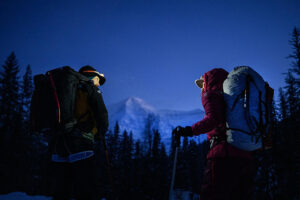Luke Smithwick completed his 71st Himalayan expedition in 2019, a mix of both climbing and skiing. By numbers alone, this makes the 39-year-old American one of the most experienced modern explorers in the region.

Luke Smithwick. Photo: Fisher Creative
He first visited the Himalaya in 2001 and immediately fell in love with them. While he accepts that high-level alpinism, 8,000m climbs and big ski descents are necessary for the sporting world, he feels that “we are currently in a real drought for depth in mountain pursuits.”
Smithwick is more driven by the cultures and people in each new area he explores. And this is where he gets ideas for new expeditions. In 2010, he started the HIMALAYA 500. Even in this era of tick lists, it is a project like no other. On the surface, the goal is to ski 500 lines in the Himalaya, but Smithwick explains that it’s mainly an effort to tell a larger story about the Himalaya, its people and climate change. Local people have been skiing the Greater Ranges for decades, and he wants to make this “more a project about humanity,” he says.
He is currently a third of the way through. Until now, he has nibbled away at it during two- or three-week trips, “skiing a lot of vertical each day…and ticking off multiple lines in a week.”
He now plans to devote more time to the remainder of those 500 lines. “I expect to be done in the next three or four years,” he says.

Smithwick climbs a 6,300m ski line in the Indian Himalaya. Photo: Luke Smithwick
Along the way, he hopes to showcase the skiing potential in the Himalaya. “There’s a lot of great skiing at lower elevations, about 4,000m, from Pakistan to Kashmir all the way to Bhutan.”
His lines have varied in both difficulty and type, from “powder skiing to forested terrain that has really nice glade skiing, all the way to technical couloirs at altitudes that are steep, require certain snow conditions and can only be safely skied in spring or summer.” Smithwick loves couloirs and wants them to make up a large proportion of his final lines.
Even though he has skied Shishapangma and plans to ski further 8,000m peaks for the project, he has mostly focused on lines between 4,000 and 6,500m. He openly admits that “not every one of these lines is going to be a historic descent.” He chose 500 as his goal “to show how much variety there is here, from ski touring and powder skiing, to backcountry skiing and ski mountaineering.”

Smithwick in the Nepal Himalaya near Hiunchuli. Photo: Luke Smithwick
Remarkably, none of his lines repeat existing descents; they have all been new. To find pioneering routes, he often uses the geology of the area as a guide. He also draws on his background as an avalanche forecaster in Kashmir to assess the safety of each descent. “In remote areas of the Himalaya, daily avalanche forecasts don’t exist. I dig snow pits, I observe and always pick very conservative terrain because it’s so remote.”
From high-altitude deserts and glaciers to more continental areas, Smithwick has encountered an array of snow conditions on this project. His favorite is inter-mountain snow climates with lots of snow. “I really love Kashmir and Humla in far west Nepal — those two areas get the most snow.”
Although skiing is possible year-round in the Himalaya, the best season is February to April. “That’s when you get really good powder snow. In summer, we’re skiing on glaciers at 5,000m.”

Smithwick in the Annapurna Sanctuary early last year. Photo: Luke Smithwick
When most people think of the Himalaya, they think of climbing 8,000m peaks or trekking. Smithwick is trying to adjust that perception. “The Himalaya are a big future destination for skiing in Asia,” he says.
You can follow the HIMALAYA 500 project here.






